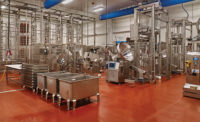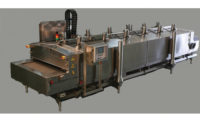Opportunities to improve snack and bakery facility food safety continually arise, whether related to sanitation and washing systems, packaging reliability, keeping an eye on best practices for managing carcinogens, or analyzing new technology that can help provide a safer work environment.
Clean, sanitary and secure
“One best practice for peak food safety is to buy/specify equipment that is easy to clean,” says Craig A. Souser, president/CEO, JLS Automation, York, PA. “Work with your OEMs to get recommended methods for cleaning.”
Kevin Quinn, sales manager, Douglas Machines Corp., Clearwater, FL, recommends ensuring that the items being used to process, store and distribute products are kept clean and sanitized. “Every Douglas washer is designed to clean and sanitize using either hot water or chemical sanitation. As evidence of the drive toward food safety, I’ve worked with companies whom, in the past, struggled with the decision to purchase a washer based on reduced labor, water and detergent use, but have decided in favor of automating their sanitation process primarily based on ensuring that the trays, toes, etc. that they use are consistently washed and sanitized.”
Sanitation also extends to packaging seals. “With the significant emergence of single-serve snacks (protein) as well as the trend from health-conscious consumers toward preservative-free products, the importance of well-sealed packages becomes paramount to food safety and consumer safety,” says Bill Burnard, packaging integrity sales and business development manager, North America, INFICON, Bad Ragaz, Switzerland.
However, traditional leak-testing techniques such as water baths aren’t capable of reliably detecting when a product has micro leaks, and micro leaks can cause microbial growth and rancidity, notes Burnard. “Compounding these leakage issues, the implication of protein gone bad is much more substantial than chips gone stale.”
“The Contura S400 delivers non-destructive, quantitative, fast leak testing that eliminates multiple human variables, as well as provides testing techniques and data that can simultaneously find micro leaks and massive leaks,” says Burnard. “The Contura S400’s HMI provides a uniform and simple approach to testing that eliminates many unavoidable operator dependencies in water bath testing.”
Many companies have found that the Contura S400 can be a productivity asset. “Companies have found that they’re able to increase the frequency of testing enough to identify issues with equipment that weren’t previously attributable to leakage and, thus, they’re able to manage preventative maintenance and equipment uptime in ways that enhance productivity, and not just quality,” says Burnard.
When considering the natural tension in the market drivers of compostable packaging and reductions in preservatives, food safety can be one of the first critical priorities to be put into jeopardy, Burnard says. “The fast, simple, quantitative, non-destructive leak testing techniques of the Contura S400 can help companies bridge the gap created by these two diametrically opposed market drivers.”
Acrylamide update
“Acrylamide is formed when carbohydrate-rich foods are baked, fried, roasted or toasted,” says Mike Woulfe, vice president, business development, enzymes, Kerry, Beloit, WI. Food items of concern include dry snack and bakery products with low moisture levels, like crackers, potato chips and breads. He notes that a common rule of thumb is that items that develop browner coloring contain high acrylamide levels.
Kerry released Acryleast, an ingredient that can reduce acrylamide content by up to 93 percent, in January 2019 via a license with Renaissance BioSceience. Acryleast does not act like yeast (it has no fermentation) and it has no impact on taste or texture. It also doesn’t require any change to the manufacturing process, and is listed on the ingredient label as “yeast.” It’s considered “organic suitable” in the U.S.
“Many customers have initiated lab-scale and plant-scale trials with Acryleast and found it reduces acrylamide levels in many different food products without changing any manufacturing processes,” says Woulfe. “Dosage and application methods vary between the different food products, achieving results that range from 85 percent reduction in baby biscuits (lab) and 93 percent in crackers (plant).”
EU regulators are concerned about excessive levels of acrylamide in baby and children’s biscuits, cereals, crackers and toast, and are talking about setting maximum allowable levels in the very near future, says Woulfe. “This is why European food safety authorities—such as the UK’s Food Standards Agency in its ‘Go for the Gold’ consumer education campaign—recommend that consumers and restaurants toast bread, french fries and chips to a light golden-brown color only. A darker color signals that more acrylamide is being formed in the cooking process.” Simply taking care of this problem at the food manufacturing level is the next logical step.
“Kerry has been a fantastic global partner since we signed the licensing deal, as they are committed to addressing the acrylamide and other food manufacturing problems with safe, highly effective solutions like Acryleast,” says Cormac O’Cleirigh, chief business development officer, Renaissance BioScience, Vancouver, British Columbia.
A microbial spotlight
Many pathways exist toward broadening our industry approach toward food safety. According to Kristin May, chief commercial operations officer, Vital Vio, Troy, NY, in order to achieve peak food safety, food producers must shift from intermittent cleaning to continuous antimicrobial sanitization. “There is a major gap in the sanitization process by only physically ‘cleaning’ a couple times each day—or worse, doing a deep scrub just once a week,” she says. “To stop microbes before they even have the potential of coming into contact with food, facilities managers must layer in new technologies that enable them to take an ‘always on’ approach to sanitization.”
“The introduction of the Food Safety Modernization Act is helping food processors reprioritize how they keep their facilities clean,” says May. And the adoption of antimicrobial LED lighting represents an easy first step to protecting the wider food processing environment. “Once installed, this particular solution requires zero additional manpower or financial investment. And in fact, it can deliver a measurable return on investment almost immediately with reductions and changes in other cleaning approaches.”
Vital Vio developed its patented antimicrobial LED technology to effectively kill bacteria and continuously protect against fungi, yeast and mold in high-risk environments, says May. “The company’s LED technology accomplishes this through generating a very precise spectrum of visible light, which, when shined on a particular surface, initiates a photoactivation that takes place exclusively inside microbes. This frequency produces reactive oxygen species (ROS). With the buildup of ROS inside this microbes, it destroys the cellular structure resulting in bacterial cell death. While these lights meet the standards for continuous and unrestricted use around people, animals and plants, they work to create a continuously inhospitable environment for microbes to spread or multiply into bacterial colonies.”









